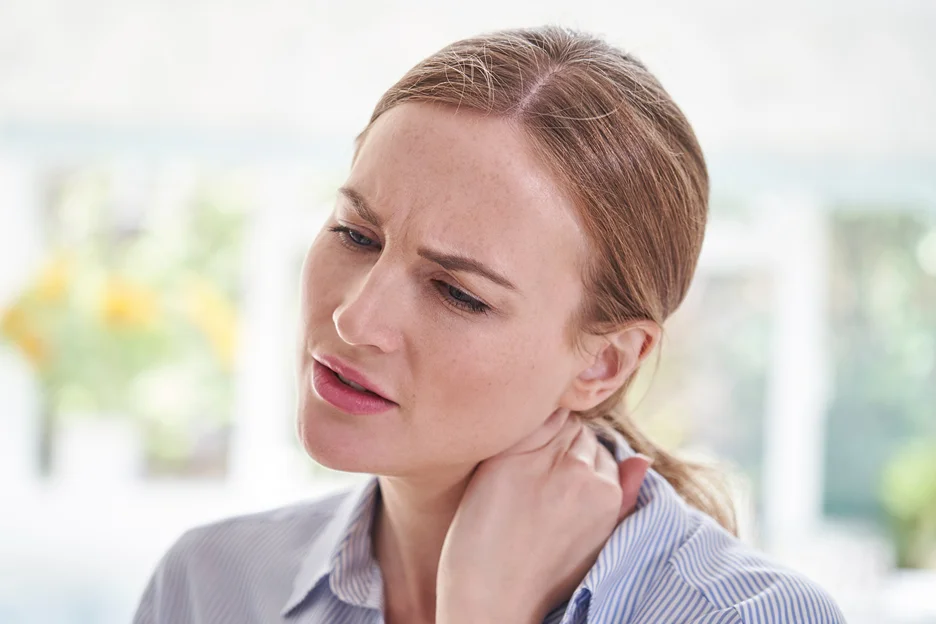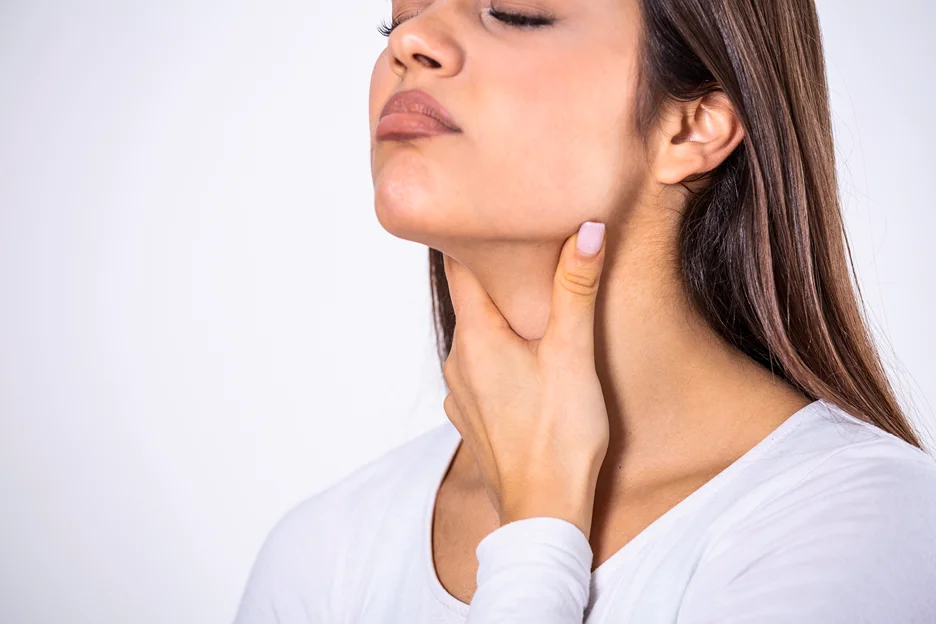Eustachian tube dysfunction (ETD) can surprisingly trigger neck pain. When the tube connecting the middle ear becomes inflamed or blocked, irritation spreads to surrounding nerves and muscles.
This causes referred pain radiating down the neck, along with protective muscle splinting that leads to stiffness. Symptoms include soreness, popping sensations, and ear pain traveling into the neck. The root ETD cause must be addressed for relief. This article dives deep into how ETD mechanisms create neck pain as explained by our specialists.
Can ETD cause neck pain?

Eustachian tube dysfunction (ETD) does not directly cause neck pain. The eustachian tubes connect the middle ears to the back of the nose and throat and help equalize pressure. When these tubes become obstructed, it can create a feeling of ear fullness, muffled hearing, and ear pain.
However, ETD may indirectly contribute to neck pain in some cases. Research by Dr. Ross Hauser at Caring Medical suggests that cervical spine instability can disrupt proper functioning of the muscles that open and close the eustachian tubes.
This could allow fluid buildup and a feeling of clogged ears. The body may then tense neck muscles as a protective response, trying to stabilize the area. This compensatory tightening can reduce neck mobility and cause painful muscle spasms.
In addition, cervical instability is associated with sinusitis, which can further exacerbate ETD. The inflammation from sinusitis may contribute to eustachian tube swelling and neck muscle tension as well.
So while ETD itself does not directly cause neck pain, it appears a bidirectional relationship may exist in some cases. Underlying spinal instability could contribute to ETD, while the body’s response to ETD may trigger secondary neck pain. Treating both the cervical and eustachian tube issues is important for managing discomfort.
What are the symptoms of ETD causing neck pain?
Eustachian Tube Dysfunction (ETD) can cause a variety of symptoms, some of which may indirectly lead to neck pain. ETD occurs when the Eustachian tube, which connects the throat to the ears, gets clogged. This can lead to symptoms such as ear fullness, ear pain, and hearing difficulties.
Kaly specialists also advise patients of the symptoms of ETD, which include dizziness, imbalance, lightheadedness, vertigo, and tinnitus. These symptoms can result from fluid accumulation in the inner ear due to ETD.
A cross-sectional study published on the National Center for Biotechnology Information (NCBI) website discusses the association between neck pain and health-related quality of life. The study found that neck pain can lead to significant disability, with almost 5% of adults being significantly disabled by neck pain during any 6-month period.
Paying attention to these types of symptoms along with neck pain can help identify if ETD is a contributing factor.
Can Eustachian Tube Dysfunction cause a stiff neck?
Yes, eustachian tube dysfunction indirectly cause neck stiffness. When the eustachian tube becomes obstructed or inflamed, the body instinctively tightens and splints the muscles around it to try to stabilize and protect the area.
This muscular splinting involves tensing the neck muscles to reduce motion around the irritated tube. While this is a protective response, it leads to the familiar sensation of a “stiff neck” with tension, soreness, and difficulty turning the head.
The StatPearls book on the anatomy of the Eustachian tube explains that the tube is closely linked to the infratemporal fossa and is located in the para-pharyngeal space. It is controlled by six muscles, including the tensor tympani, salpingopharyngeus, tensor veli palatini, levator veli palatini, and the lateral and medial pterygoids.
These muscles play an active role in the functions of the tube. Any anatomic and physiologic variations within the Eustachian tube, such as a narrower tube diameter or flaccidity of the cartilaginous portion of the tube, can lead to ETD.
Can neck problems trigger ETD?
Existing neck injuries or conditions may increase your likelihood of developing eustachian tube dysfunction. Misalignment in the upper cervical spine can cause muscles in the Eustachian tubes to flex irregularly, leading to ETD. This can result in fluid buildup, ear pressure, or ear pain.
As for poor posture as a possible cause, a study published on PubMed tested the function of the Eustachian tube in different body postures. The study found that the postural effect on the tubal function is slight, suggesting that poor neck posture might not have a significant impact on ETD.
- Chronic muscle tension spreading upward from the neck can also cause inflammation around the tube opening.
- Pre-existing cervical spine problems like arthritis or damaged discs may also contribute to ETD risk by impacting mobility and muscular function in the neck.
Careful neck strengthening, posture correction, and manual therapy can sometimes help prevent this cascade from neck to ETD issues.
An article by Cambridge Osteopathy discusses how manual therapy by osteopaths can help relieve ETD. The article mentions the Muncie Technique, a manipulative technique to relieve Eustachian tube dysfunction. This article suggests that manual therapy, which often involves manipulation of the neck and spine, can help manage ETD.
Does a patulous Eustachian tube cause neck pain?
Yes. A patulous Eustachian tube, where the tube remains chronically open, is also associated with repeated neck pain. In this condition, sounds and air pressure changes transmit directly through the open tube to the middle ear, creating sensations of echoing/reverberation.
To dampen this, the body chronically tenses muscles like the tensor veli palatini. This repetitive muscle tension to protect the overly sensitive middle ear can lead to chronic discomfort, stiffness, and pain in the neck over time.
“Eustachian Tube Dysfunction” from StatPearls – NCBI Bookshelf explains that the Eustachian tube opens on positive pressure, such as yawning, sneezing, swallowing, and the Valsalva maneuver, by contraction of the levator veli palatini and tensor veli palatini muscles.
Can ETD cause a sore throat?

No, current evidence does not strongly support eustachian tube dysfunction directly causing sore throat symptoms. While ETD involves inflammation that could potentially spread to the throat area, studies have not found a clear association. Post-nasal drip from ETD may irritate the throat, but this is not the same as causing primary soreness.
Based on our experience, forceful ear popping could strain throat muscles and lead to localized discomfort. However, there is little clinical data establishing this mechanism. Isolated throat pain without other upper respiratory symptoms is unlikely to be attributed to ETD specifically.
It’s also important to note that ETD does not create mucus, but post-nasal drip can sometimes contribute to ETD. More likely, a condition that creates post-nasal drip, such as a virus, could potentially cause a sore throat.
While ETD can cause ear fullness and neck stiffness, an accompanying sore throat is not a clearly established feature of this condition based on current medical literature and research. If throat pain arises alongside ETD symptoms, other potential causes should be evaluated as well.
What Treatments Help Relieve Neck Pain Caused by Eustachian Tube Dysfunction?
Specialists may prescribe oral decongestants or steroid nasal sprays to reduce inflammation of the Eustachian tubes. This helps open and normalize tube function, relieving pulling on the neck.
A study conducted on 50 children with chronic or recurrent otitis media with effusion (OME) found that oral decongestants like pseudoephedrine hydrochloride could improve Eustachian tube function. The study found that the decongestants could partially restore the function of the Eustachian tube, especially after the subjects had received four doses of the decongestant.
Performing the Valsalva maneuver can also force the tubes open to release pressure. A study that used dynamic slow motion video endoscopy (DSVE) and the Eustachian Tube Dysfunction Questionnaire (ETDQ-7) to evaluate Eustachian tube function found that the Valsalva maneuver could be useful for equalizing middle ear air pressure.
The maneuver involves forceful expiration while keeping the mouth and nose closed until the ears “pop.” The study found that if patients felt a decrease in ear fullness or a more ventilated sense in one ear after the Valsalva maneuver, the function of the Eustachian tube in that ear was considered normal.
See an ENT specialist for proper diagnosis and multi-modal treatment to open the tubes, reduce inflammation, and address muscular issues for lasting relief.
Connect with a Top Ear, Nose, and Throat Doctor

As you research options for resolving persistent neck and ear issues, we encourage utilizing Kaly’s medical services to find the right ENT or orthopedic specialist for your needs.
Our innovative search platform and scheduling system make it simple to research providers based on condition, insurance, and availability – and conveniently book an optimal appointment time.
Kaly also collates transparent online reviews from multiple trusted sites to aid in selecting the right provider for you. Begin your search and take control of resolving chronic neck and ear discomfort with help from a highly-rated specialist.
